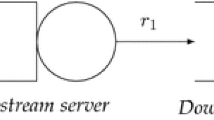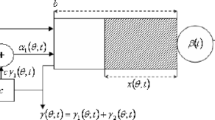Abstract
We consider a class of fluid queueing networks with multiple fluid classes and feedback allowed, which are fed by N heavy tailed ON/OFF sources. We study the asymptotic behavior when N→∞ of these queueing systems in a heavy traffic regime (that is, when they are asymptotically critical). As performance processes we consider the workload W N (the amount of time needed for each server to complete processing of all the fluid in queue), and the fluid queue Z N (the quantity of each fluid class in the system). We show the convergence of \(\sqrt{N}W^{N}\) and \(\sqrt{N}Z^{N}\) (to \(\hat{W}\) and \(\hat{Z}\) ) in heavy traffic if state space collapse (SSC) holds. (SSC) is a condition that establishes a relationship between those components of \(\hat{Z}\) that correspond to fluid classes processed by the same server, which implies that \(\hat{Z}=\Delta\hat{W}\) for a deterministic lifting matrix Δ. Our main contribution is to prove that assuming that the other hypotheses are true, (SSC) is not only sufficient for this convergence, but necessary. Furthermore, we prove that processes \(\hat{W}\) and \(\hat{Z}\) , conveniently scaled in time, converge to W (a reflected fractional Brownian motion) and Z (=ΔW). We illustrate the application of our results with some examples including a tandem queue.
Similar content being viewed by others
References
Bernard, A., el Kharroubi, A.: Régulations déterministes et stochastiques dans le premier orthant de \(\Bbb{R}^{n}\) . Stoch. Stoch. Rep. 34, 149–167 (1991)
Billingsley, P.: Convergence of Probability Measures. Wiley, New York (1968)
Bramson, M.: Convergence to equilibria for fluid models of FIFO queueing networks. Queueing Syst. 22, 5–45 (1996)
Bramson, M.: State space collapse with application to heavy traffic limits for multi-class queueing networks. Queueing Syst. 30, 89–148 (1998)
Dai, J.G., Wang, Y.: Nonexistence of Brownian models for certain multi-class queueing networks. Queueing Syst. 13, 41–46 (1993)
Debicki, K., Mandjes, M.: Traffic with an fBm limit: convergence of the stationary workload process. Queueing Syst. 46, 113–127 (2004)
Delgado, R.: A reflected fBm limit for fluid models with ON/OFF sources under heavy traffic. Stoch. Process. Appl. 117, 188–201 (2007)
Harrison, J.M.: Balanced fluid models of multi-class queueing networks: a heavy traffic conjecture. In: Kelly, F.P., Williams, R.J. (eds.) Stochastic Networks. IMA Volumes in Mathematics and its Applications, vol. 71, pp. 1–20. Springer, New York (1995)
Harrison, J.M., Nguyen, V.: Brownian models of multi-class queueing networks: current status and open problems. Queueing Syst. 13, 5–40 (1993)
Iglehart, D.L., Whitt, W.: Multiple channel queues in heavy traffic I. Adv. Appl. Probab. 2, 150–177 (1970)
Iglehart, D.L., Whitt, W.: Multiple channel queues in heavy traffic II. Adv. Appl. Probab. 2, 355–364 (1970)
Konstantopoulos, T., Lin, S.J.: Fractional Brownian approximations of stochastic networks. In: Stochastic Networks, Stability and Rare Events. Lecture Notes in Statistics, vol. 117, pp. 257–274 (1996)
Majewski, K.: Fractional Brownian heavy traffic approximations of multi-class feedforward queueing networks. Queueing Syst. 50, 199–230 (2005)
Peterson, W.P.: Diffusion approximations for networks of queues with multiple customers types. Math. Oper. Res. 16, 90–118 (1991)
Reiman, M.I.: Open queueing networks in heavy traffic. Math. Oper. Res. 9(3), 441–458 (1984)
Reiman, M.I.: Some diffusion approximations with state space collapse. In: Baccelli, F., Fayolle, G. (eds.) Proc. of the Internat. Seminar on Modeling and Performance Evaluation Methodology. Lecture Notes in Control and Information Sciences, pp. 209–240. Springer, New York (1984)
Taqqu, M.S., Willinger, W., Sherman, R.: Proof of a fundamental result in self-similar traffic modeling. Comput. Commun. Rev. 27, 5–23 (1997)
Whitt, W.: Weak convergence theorems for priority queues: preemptive resume discipline. J. Appl. Probab. 8, 74–94 (1971)
Williams, R.J.: On the approximation of queueing networks in heavy traffic. In: Kelly, F.P., Zachary, S., Ziedins, I. (eds.) Stochastic Networks: Theory and Applications, pp. 35–56. Oxford Univ. Press, Oxford (1996)
Williams, R.J.: An invariance principle for semimartingale reflecting Brownian motions in an orthant. Queueing Syst. 30, 5–25 (1998)
Williams, R.J.: Diffusion approximations for open multi-class queueing networks: sufficient conditions involving state space collapse. Queueing Syst. 30, 27–88 (1998)
Author information
Authors and Affiliations
Corresponding author
Additional information
Supported by project MEC-FEDER ref. MTM2006-06427.
Rights and permissions
About this article
Cite this article
Delgado, R. State space collapse for asymptotically critical multi-class fluid networks. Queueing Syst 59, 157–184 (2008). https://doi.org/10.1007/s11134-008-9080-y
Received:
Revised:
Accepted:
Published:
Issue Date:
DOI: https://doi.org/10.1007/s11134-008-9080-y
Keywords
- State space collapse
- Reflected fractional Brownian motion
- Fluid model
- Multi-class queueing network
- Workload process
- Fluid queue process
- On-off sources
- Heavy traffic
- Completely-S matrix
- Tandem queue




